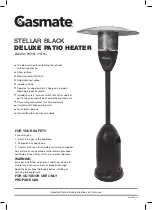
4
LEAKAGE CHECKPOINTS
A. Water at the blower assembly is water vapor which
has condensed out of the combustion products. This
is caused by a problem in the vent or blockage in the
drain coupling.
B. Condensation may be seen on pipes in humid weather
or pipe connections may be leaking.
C. The anode rod
fi
tting may be leaking.
D. Small amounts of water from temperature-pressure
relief valve may be due to thermal expansion or high
water pressure in your area.
E. *The temperature-pressure relief valve may be leaking
at the tank
fi
tting.
F. Water from a drain valve may be due to the valve being
slightly opened.
G. The drain valve may be leaking at the tank
fi
tting.
H. Combustion products contain water vapor which can
condense on the cooler surfaces of the tank. Droplets
form and drip onto the burner. This is common at the
time of start-up after installation and when incoming
water is cold.
I. Water in the water heater bottom or on the
fl
oor may be
from condensation. DO NOT replace the water heater
until a full inspection of all possible water sources is
made and necessary corrective steps taken.
J. Leakage from other appliances, water lines, or ground
seepage should also be checked.
* To check where threaded portion enters tank, insert
cotton swab between jacket opening and
fi
tting. If cotton
is wet, follow draining instructions in the “Draining
and Flushing” section in the Manual and then remove
fi
tting. Put pipe dope or Te
fl
on® tape on the threads
and replace. When you are
fi
nished, follow the steps
in “Filling the Water Heater” section in the Manual.
A
C
B
D
E
F
G
I
H
Figure 2





































